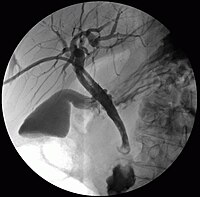
Photo from wikipedia
Background and Aim: Endoscopic stents in the common bile duct is the first treatment choice to alleviate symptoms of biliary obstruction due to malignant disease. When endoscopic stenting fails in… Click to show full abstract
Background and Aim: Endoscopic stents in the common bile duct is the first treatment choice to alleviate symptoms of biliary obstruction due to malignant disease. When endoscopic stenting fails in palliative patients, one option is to use a percutaneous transhepatic biliary drainage, but it is not clear whether and how it can reduce the symptom load. The aim of this study was to evaluate benefits and disadvantages of percutaneous transhepatic biliary drainage in palliative care. Material and Methods: Inclusion criteria were malignant disease and bilirubin ≥26 µmol/L in plasma. A structured protocol for obtaining data from the medical records was used. Data were collected from the time of last computed tomography scan before the percutaneous transhepatic biliary drainage was placed and during 14 days afterward. Results and Conclusion: Inclusion criteria were fulfilled in 140 patients. Median age was 70 years (33–91 years). Some 126 patients had a remaining external percutaneous transhepatic biliary drainage. Jaundice was the initial symptom in 62 patients (44%). Within the first week after percutaneous transhepatic biliary drainage, the bilirubin decreased from 237 µmol/L (31–634) to 180 µmol/L (17–545). Only 25% reached a level below the double upper reference value. Pruritus occurred in 27% before the percutaneous transhepatic biliary drainage, but the bilirubin value did not differ from patients without pruritus. However, the pruritus was relieved in 56% with percutaneous transhepatic biliary drainage. Antibiotic prophylaxis protected to some extent from infectious complications. Adverse events were common and early mortality was high (16% within 14 days). Jaundice should not by itself be an indication for percutaneous transhepatic biliary drainage for palliation except when the aim is to prepare the patient for chemotherapy. It is mandatory that the patients are informed carefully about what can be expected regarding the positive effects and the risks of adverse events.
Journal Title: Scandinavian Journal of Surgery
Year Published: 2018
Link to full text (if available)
Share on Social Media: Sign Up to like & get
recommendations!